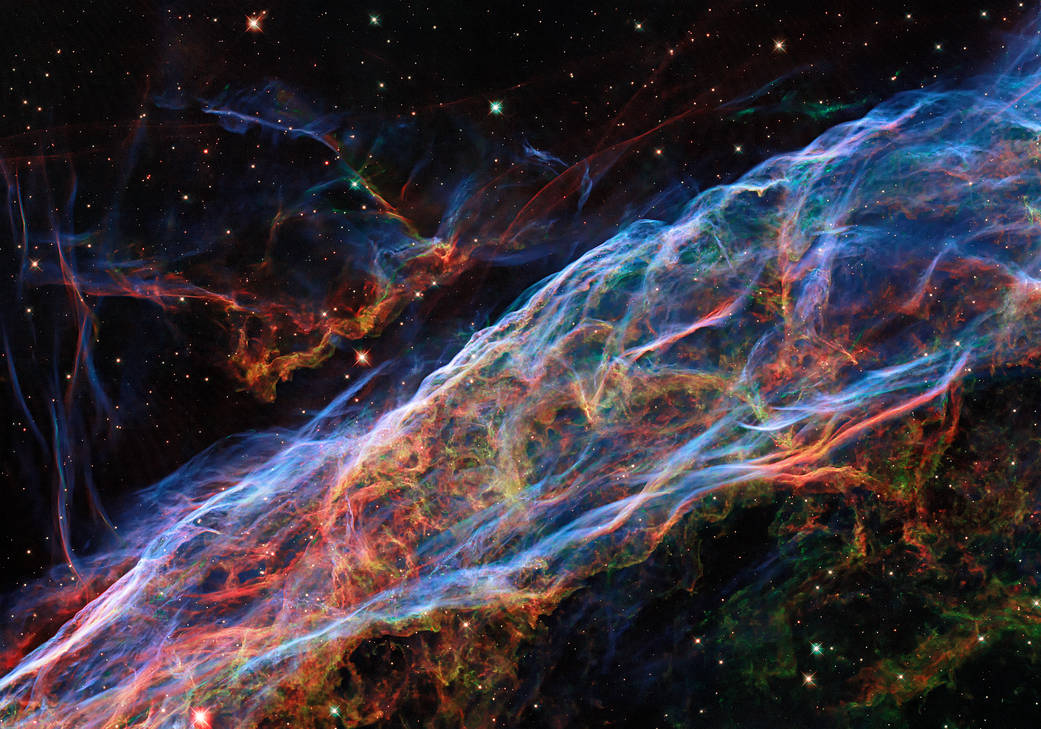This image taken by the NASA/ESA Hubble Space Telescope revisits the Veil Nebula, which was featured in a previous Hubble image release. In this image, new processing techniques have been applied, bringing out fine details of the nebula’s delicate threads and filaments of ionized gas.
To create this colorful image, observations were taken by Hubble’s Wide Field Camera 3 instrument using five different filters. The new post-processing methods have further enhanced details of emissions from doubly ionized oxygen (seen here in blues), ionized hydrogen, and ionized nitrogen (seen here in reds).
The Veil Nebula lies around 2,100 light-years from Earth in the constellation of Cygnus (the Swan), making it a relatively close neighbor in astronomical terms. Only a small portion of the nebula was captured in this image.
The Veil Nebula is the visible portion of the nearby Cygnus Loop, a supernova remnant formed roughly 10,000 years ago by the death of a massive star. That star – which was 20 times the mass of the Sun – lived fast and died young, ending its life in a cataclysmic release of energy. Despite this stellar violence, the shockwaves and debris from the supernova sculpted the Veil Nebula’s delicate tracery of ionized gas – creating a scene of surprising astronomical beauty.
The Veil Nebula is also featured in Hubble’s Caldwell Catalog, a collection of astronomical objects that have been imaged by Hubble and are visible to amateur astronomers in the night sky.
Text credit: European Space Agency (ESA)
Image credit: ESA/Hubble & NASA, Z. Levay
NASA/ESA哈勃太空望远镜拍摄的这张照片再现了面纱星云的景象,该星云曾在哈勃太空望远镜发布的一张照片中出现过。在这幅图像中,应用了新的处理技术,呈现出星云精致的线状物和电离气体丝的细节。
为了制作这张色彩斑斓的图像,哈勃望远镜的3号广角相机使用五种不同的滤镜进行了观测。新的后期处理方法进一步增强了双电离氧(此处为蓝色)、电离氢和电离氮(此处为红色)释放的细节。
面纱星云位于天鹅座,距离地球约2100光年,从天文学角度来说,它是一个相对较近的邻居。这张图片只拍摄到了星云的一小部分。
面纱星云是附近的天鹅座环形星云的可见部分,这是大约一万年前由一颗大质量恒星死亡形成的超新星遗迹。那颗恒星的质量是太阳的20倍,它活得很快,死得很早,在一场灾难性的能量释放中结束了自己的生命。尽管存在这种恒星暴力,但超新星产生的冲击波和碎片却塑造了面纱星云细腻的电离气体轨迹——创造出一幕幕令人惊讶的天文美景。
面纱星云还被收录在哈勃的考德威尔星表中,这是哈勃拍摄的天体集合,业余天文学家在夜空中可以看到它。
文字来源:欧洲航天局(ESA)。
图片来源:ESA/Hubble & NASA, Z. Levay







